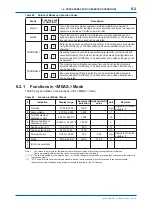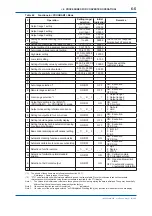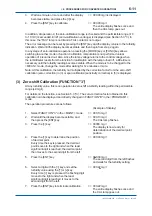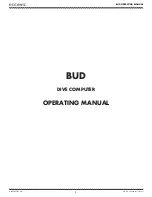
<5. FUNCTIONS>
5-8
IM 12E04A02-02E
Table 5.7 Functions Related to Contact Output
Function
Description
Contact
Mode
FUNCTION
Selection of maintenance
contact output open or close
Open or closed (factory setting)
M1, M2
PROGRAM 2
C
Selection of FAIL contact output
open or close
Open (factory setting) or closed
F1, F2
PROGRAM 2
D
Selection of upper and lower
limit alarm output open or close
Open (factory setting) or closed
C1, C2
PROGRAM 2
E
Selection of automatic cleaning
or zero calibration output open
or close
Open or closed (factory setting)
C1, C2
PROGRAM 2
F
Selection of C1 and C2 outputs
Selection of upper and lower limit
alarm output or automatic cleaning
or calibration output
C1, C2
PROGRAM 2
E.
5.6 Other
Functions
Table 5.8 shows other functions.
Table 5.8 Other Functions
Function
Description
Mode
FUNCTION
Converter check
It can be con
fi
rmed that the converter operates normally.
MAINT.
9
Setting of turbidity
signal average factor
Setting of the average factor of turbidity indication analog
output
PROGRAM 1
4
5.6.1
Overview of the Spike Detection Function
If air bubbles occur or dust is present on the sample surface of the detector's measuring cell at
which the light is scattered, the reading, in general, rises rapidly. The
fl
uctuation is dependent on
the size of air bubbles or dust and their behavior on the sample surface.
A head tank is supplied when the TB400G with a sampling system is speci
fi
ed. It is for removing
air bubbles and thus for preventing them from reaching the detector. In rare cases, however,
air bubbles occur and grow in the pipe between the head tank and the detector, and rise to the
surface of the measuring cell, resulting in reading
fl
uctuation.
The converter has a signal averaging function with a user-con
fi
gurable averaging factor.
Small changes in readings due to air bubbles or dust can be compensated for, to some degree,
by increasing the averaging factor. However, it is not practical to set the averaging factor too high
because it can cause a delay in the response of the turbidity signal.
The spike detection function is the one of detecting and suppressing a rapid change due to air
bubbles or dust, preventing it from affecting the reading and output. (Note that this function is
available in models with ROM number K9410SE with version 1.04 or later.)
How It Functions
To suppress a rapid change due to air bubbles or dust, the TB400G:
(1) checks a turbidity signal before averaging;
(2) calculates the difference between the current signal and the previous signal;
(3) compares the difference with the Detection Level;
(4) if it is less than the Detection Level, proceeds to averaging and gives the turbidity reading;
(5) if it is greater than the Detection Level, holds the output for a speci
fi
ed Hold Time period;
(6) during that period, suspends the Detection Level check;
3rd Edition : May. 31, 2010-00
Summary of Contents for Vigilant Plant EXA TB Series
Page 49: ...Blank Page ...
Page 59: ...Blank Page ...
Page 119: ...Blank Page ...
Page 125: ...Blank Page ...
Page 127: ...Blank Page ...
Page 133: ...Blank Page ...
















































